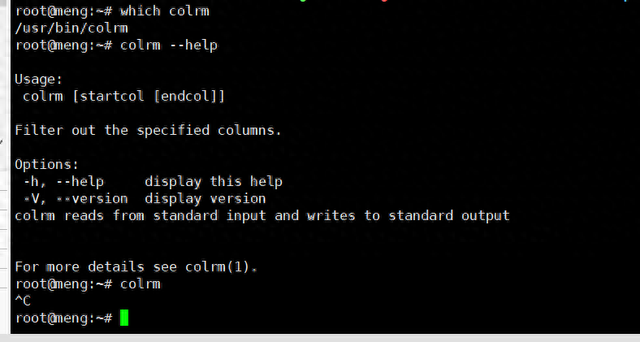在linux操作系统下 colrm命令介绍和使用案例
colrm 是一个用于从文本文件中删除指定列的命令行工具。它可以非常方便地处理文本数据,特别是在需要去掉特定字符时。
colrm 命令介绍功能colrm 命令用于从输入的文本中移除指定的列。列是指文本行中的单个字符,列编号从 1 开始。
语法bashcolrm [start [stop]]start:要删除的起始列号。stop:要删除的结束列号。如果只指定了起始列,则会删除从该列开始到行末的所有列。工作原理如果只指定了起始列,colrm 将删除该列及其之后的所有列。如果同时指定了起始列和结束列,colrm 将删除这两个列之间的所有列。命令:
root@meng:~# which colrm
/usr/bin/colrm
root@meng:~# colrm --help
Usage:
colrm [startcol [endcol]]
Filter out the specified columns.
Options:
-h, --help display this help
-V, --version display version
colrm reads from standard input and writes to standard output
For more details see colrm(1).
root@meng:~# colrm
^C
root@meng:~#

命令案例:
root@meng:~# ls
f1.txt.bz2 f2.txt.bz2 m1.txt meng.txt meng.txt.bz2 rec00001f1.txt snap tmp
root@meng:~# more m1.txt
hello men
g
hello meng
g
Hello World
This is a test
HelloWorld
Hello World
This is a test
root@meng:~# colrm 2 3 < m1.txt > m2.txt
root@meng:~# more m1.txt
hello men
g
hello meng
g
Hello World
This is a test
HelloWorld
Hello World
This is a test
root@meng:~# more m2.txt
hlo men
g
hlo meng
g
his is a test
HloWorld
his is a test
root@meng:~#
